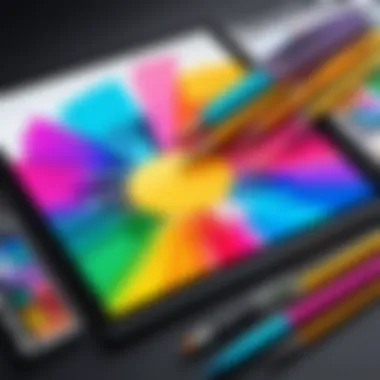Exploring Free Drawing Editing Software: A Comprehensive Guide


Intro
In the realm of digital art and design, free drawing editing software stands out as a vital resource for aspiring artists, experienced designers, and creative thinkers. Such software not only democratizes access to artistic tools but also enhances the creative process across various platforms. Understanding the dynamics of these tools is essential to make informed decisions. This article delves into the complexities of free drawing editing tools, their functionalities, and the potential benefits they offer to users.
This analysis aims to facilitate a deeper understanding of the available software, how each tool serves unique artistic needs, and the overall impact on creative endeavors.
Intro to Drawing Editing Software
Drawing editing software has evolved into a fundamental tool for both professional and amateur artists in the modern creative landscape. The increasing shift toward digital media requires a nuanced understanding of how these programs can enhance productivity, creativity, and workflow. Understanding the role of drawing editing software is crucial in navigating the varied options available in today’s marketplace.
Definition and Purpose
Drawing editing software includes various applications that provide users the ability to create, modify, and enhance digital artworks. These tools offer functionalities such as vector graphics creation, raster image editing, and even 3D modeling. The main purpose of these applications is to empower artists and designers to bring their ideas to life through digital means.
The software typically includes features like layers, brushes, color adjustments, and text manipulation, which facilitate a more flexible approach to creativity. For professionals, the purpose extends beyond mere creation; it encompasses collaboration, project management, and the need for scalable solutions that can cater to varying project demands.
Importance in the Digital Age
In the digital age, the importance of drawing editing software cannot be overstated. It has transformed traditional art forms and made them accessible to a larger audience. Digital tools have democratized art creation, enabling nearly anyone with a device to express their creativity. Moreover, the rise of online platforms and social media has changed how artists share their work.
"The accessibility of free drawing editing software has opened the doors for countless individuals to pursue artistic endeavors without financial barriers."
As creative fields grow increasingly competitive, navigating this software landscape is a critical skill for artists, designers, and businesses alike. Free drawing editing software provides an excellent entry point for those seeking to explore their creative potential without substantial financial investment. This aspect highlights the software's role not just in individual projects, but also in nurturing talents that may contribute to a larger artistic community.
Overview of Free Options
In the realm of creative software, the availability of free drawing editing tools marks a significant democratization of artistic expression. The overarching discussion in this section centers on the various free options available and their relevance to both amateur artists and seasoned professionals. Free drawing software often provides essential functionalities that empower users to engage in their creative processes without facing the financial constraints that typically accompany premium solutions. This opens the gate to experimentation and innovation by enabling more people to access digital art tools.
Benefits of Using Free Software
Utilizing free drawing editing software comes with several notable advantages. Here are some key benefits:
- Cost-Effectiveness: As the name suggests, these tools are free. This makes them accessible for individuals and small businesses who may have limited budgets.
- Basic Functionality: Many free drawing software options come equipped with fundamental features for effective drawing, including brushes, layers, and shapes. This allows for a significant amount of creativity even without premium upgrades.
- User-Friendly: They tend to have straightforward interfaces, making it easier for beginners to start drawing right away without a steep learning curve.
- Community Support: Many popular free drawing software solutions have large user communities. This can provide invaluable support, tutorials, and shared resources that can enhance learning and application.
"Having access to free tools can significantly lower the barriers for aspiring digital artists, allowing them to focus on their craft rather than the costs associated with it."
Limitations of Free Software
While the advantages are apparent, free drawing software also presents some limitations that users must consider. These may include:
- Limited Features: Free options often lack advanced features found in paid alternatives. This can hinder complex projects that require robust editing or design functionalities.
- Ad-Supported Models: Some free tools may include advertisements or require internet connectivity, which can detract from the user experience.
- Frequent Updates: Users might encounter issues with consistency and support, as free software can have less frequent updates or insufficient customer service.
- Export Limitations: Certain free software may restrict choices in file formats for saving or exporting work, which can be a drawback for professional use.
Understanding both the benefits and limitations of free software provides a balanced view. This allows users to make informed choices based on their individual needs and projects.
Criteria for Evaluating Software
When exploring free drawing editing software, it is crucial to assess specific criteria that can significantly influence user experience and overall effectiveness. This section provides a framework for understanding what to look for in such software. This evaluation helps users identify tools that not only meet their artistic needs but also complement their style of working.
Adequate analysis of software features, usability, and support can lead to an informed decision, ensuring that the chosen application enhances the creative process. Here, we break down three essential criteria: user interface and experience, functionality and features, and community support and resources.


User Interface and Experience
The user interface (UI) plays an essential role in how artists interact with drawing software. A well-designed UI can streamline tasks and make the creative process more intuitive. It is vital that users find the interface comfortable and easy to navigate. A clean, logical layout reduces the initial learning curve and allows for quicker adaptations to the software.
Key aspects to consider include:
- Layout: The arrangement of tools and menus should be organized, accessible, and customizable.
- Responsiveness: Fast loading times and smooth interactions contribute to a pleasant experience.
- User Feedback: Elements like tooltips and tutorials can aid new users in grasping functionalities without overwhelming them.
An effective UI fosters a more productive workspace and can even elevate the quality of the artwork being produced.
Functionality and Features
Functionality encompasses the actual capabilities of the software, determining what users can achieve. Look for tools that provide the essential functions for drawing, such as:
- Brush Customization: Adjustable brush sizes and settings allow for varied artistic techniques.
- Layer Management: Support for multiple layers enhances depth and facilitates complex edits.
- Export Options: Various file formats ensure flexibility when sharing or saving artwork.
The presence of advanced features such as vector editing, blending modes, and special effects can also be beneficial, depending on the user’s specific needs.
Keep in mind that not all free software will offer extensive functionality. Understanding the balance between necessary features and ease of use is crucial to finding the right match.
Community Support and Resources
A strong community around any software enhances user experience exponentially. Free software often relies on its user base for help and support. Consider:
- Forums and Discussion Boards: Platforms like Reddit or Facebook allow users to share knowledge, troubleshoot problems, and exchange tips.
- Tutorials and Guides: Availability of learning materials can accelerate users’ ability to master the software.
- Updates and Bug Fixes: A lively community often indicates ongoing development and improvements.
Having a robust support system can significantly mitigate frustration and lead to greater satisfaction when using a software tool. Knowing you can find answers to your questions or engage with fellow users enhances the overall appeal of a software choice.
Popular Free Drawing Editing Software
In the realm of digital art and design, free drawing editing software has emerged as a significant force. This popularity stems from several factors, including cost efficiency, accessibility, and the increasing demand for creative flexibility. For aspiring artists and designers, these tools often represent the first step into the world of digital creation. Moreover, they enable professionals to explore new techniques or workflows without financial commitment.
Free drawing software empowers users to express their creativity, experiment with styles, and build a portfolio without the limitations imposed by pricey alternatives. This accessibility ensures that a broader audience can engage in art, fostering a community that thrives on innovation and collaboration. Thus, understanding the various software options available becomes crucial.
Software A: Features and Usability
Software A is a compelling option for users seeking an intuitive interface combined with robust features. Its user-friendly layout allows even novices to navigate the program with ease. Key features include various brushes and customization options that support different artistic styles. Its layering capabilities are notably advanced, enabling complicated designs without overwhelming the user. Plus, the ability to export files in numerous formats increases the software's versatility for different usage scenarios, from digital portfolios to print projects.
Software B: Features and Usability
Software B focuses heavily on collaboration and community sharing. This software allows users to share their work directly with others, fostering an active feedback loop among artists. The software includes unique tools such as a vector graphics editor and template resources that cater to both beginners and experienced users. It offers stability and performance that can handle hefty projects, giving users confidence in its reliability. The frequent updates based on community feedback also help keep it relevant.
Software C: Features and Usability
Software C stands out for its adaptability and extensive toolset tailored for different types of digital art, including pixel art and illustrations. Its minimalist interface can be a double-edged sword; while it may limit the comprehensive search for tools, it allows users to focus on their creations. Features such as customizable shortcuts and built-in tutorials enhance the learning curve, making it easier for new users to grasp complex functions. This makes it a good option for both serious hobbyists and professional artists.
Software D: Features and Usability
Software D is known for its performance in handling large file sizes and complex projects. Artists often favor it for its unique features like grid settings and advanced brush controls. This software integrates well with various hardware, including tablets and styluses, ensuring responsive feedback during the creative process. Additionally, the community surrounding it provides plugins and extensions that enhance its functionality, making it a favorite among digital professionals looking to optimize their workflow.


"The evolution of free drawing software is remarkable, providing tools once confined to paid versions to a broader audience. This democratization fuels creativity and innovation."
In summary, each drawing software option has its own strengths and capabilities. Whether it is the efficiency of Software A or the community focus of Software B, the choice will largely depend on the specific needs and preferences of the user. Considering features and usability is paramount in selecting the right software that aligns with artistic goals.
Comparative Analysis
The comparative analysis of free drawing editing software serves as a critical component in this article. By evaluating multiple tools side by side, users can determine which software best meets their artistic needs and workflows. Understanding the differences in features, performance, and user satisfaction is essential for making informed decisions. This process not only highlights the strengths of specific applications but also unveils potential weaknesses, guiding users toward the most suitable options based on their unique requirements.
Feature Comparison
When discussing feature comparison, it is imperative to assess the functionalities each software offers. Different drawing editing applications may excel in varying aspects such as brush options, layer management, vector capabilities, and support for file formats. For example, some software might provide advanced tools for digital painting while others focus on vector graphics editing. The ability to create a wide range of artistic styles relies heavily on these features, underlining the importance of this comparison. Users should consider factors such as:
- Brush engines: Quality and variety of brushes.
- Layer functionality: Number and types of layers supported.
- Export options: Formats available for saving work.
- Accessibility of tools: Ease of use of the available features.
These elements significantly impact the user experience, and careful consideration can improve efficiency and creativity.
Performance Review
Performance is another crucial aspect to examine. It encompasses how well the software operates across different systems and under various workloads. This includes considerations such as speed, stability, and responsiveness of the interface. Software that frequently crashes or lags may hinder the creative process, which can be frustrating for both amateur and professional artists. Performance can also be influenced by a user’s specific hardware and operating system. Thus, benchmarks and real-world testing are vital to understand how a piece of software performs in practical applications. Users may look for:
- Load times: How quickly the software starts and responds.
- Handling large files: Ability to manage complex projects.
- Smoothness of interactions: Fluidity in drawing and editing processes.
A thorough performance review not only aids in making educated choices but also informs users about potential hardware upgrades or optimizations they may need.
User Ratings and Reviews
User ratings and reviews provide invaluable insights into the real-world experiences of individuals using free drawing editing software. Beyond technical specifications, understanding user sentiments can highlight usability issues, hidden features, and the overall satisfaction level among diverse user bases. Ratings aggregated from sources such as forums, social media, and review websites can reveal trends and preferences that are not immediately apparent through direct comparisons. Some key factors to consider in this domain are:
- Overall satisfaction ratings: General user approval ratings.
- Common issues reported: Problems users frequently encounter.
- Support and community engagement: Interaction and assistance provided by the software community.
- Updates and maintenance: Frequency of software updates and how well the company handles issues.
User feedback can guide potential users in selecting software that aligns with their expectations and needs, ensuring a smooth integration into their workflow.
"An informed decision about software is backed by comprehensive comparisons and user feedback. It allows artists to focus on creativity rather than technical challenges."
User Experience and Testimonials
User experience plays a crucial role in the effectiveness and adoption of free drawing editing software. Through user feedback and testimonials, potential users can gauge the software's usability and overall performance. Analyzing these experiences helps in understanding software strengths and weaknesses. Satisfied users often provide insights on functionality and the learning curve involved, guiding others in selecting the right tool for their needs. Furthermore, testimonials from both novice and professional artists can help in painting a comprehensive picture of the software’s value.
Case Study: Professional Artists
In the realm of digital art, professional artists frequently rely on drawing editing software to execute their creative vision efficiently. A survey of professional users paints a clear picture of which features are essential. For example, tools like Krita and GIMP have received acclaim for their brush engines, flexibility, and high level of customization. These attributes are particularly valued for high-stakes projects where precision is key.
For instance, an artist specializing in illustrations shared that using PicMonkey streamlined their workflow. The user-friendly interface facilitated quick adaptations without compromising creativity. The professional noted, "This software allows me to focus on my art rather than navigating complex menus."
Professional artists also highlight the importance of community support. Engaging with others in forums, such as Reddit, allows them to exchange tips, tricks, and workarounds. This collaborative learning environment aids in overcoming challenges often faced in digital artistry. They feel empowered to explore the full potential of their chosen software, thanks to shared experiences from fellow users.
User Experiences from Beginners
Beginners often approach free drawing editing software with a mix of excitement and uncertainty. Their experiences can vary greatly based on several factors including prior exposure to digital tools and the learning curve associated with each program. Generally, intuitive software with comprehensive tutorials, such as Medibang Paint and Inkscape, are favored by newcomers. They prefer tools that allow for exploration rather than feeling overwhelmed by complexity.


One beginner recounted their experience using OpenClip Studio. They expressed feeling lost initially but cited the importance of clearly labeled tools and an organized workspace. They stated, "Even though I struggled at first, the more I practiced, the more comfortable I felt. It was rewarding to see my skills improve."
Additionally, online resources and community forums greatly assist beginners. Tutorials on platforms like YouTube provide insights that help in overcoming initial hurdles. New users benefit from peer support as they navigate their creative processes.
In summary, user experiences – both from professionals and amateurs – provide valuable perspectives that contribute to a comprehensive understanding of free drawing editing software. Analyzing these testimonials allows prospective users to align their choices with their artistic needs and goals.
Future Trends in Drawing Editing Software
The landscape of drawing editing software is evolving rapidly. Professionals in the creative industry must adapt to these changes to maintain their competitive edge. Understanding future trends helps in identifying potential tools and features that will enhance creativity and efficiency. These trends not only redefine how art is created but also influence user experience significantly.
Integration of AI Technologies
Artificial Intelligence (AI) is entering the realm of drawing editing software at a fast pace. The application of AI enables software to understand drawing patterns and make intelligent suggestions accordingly. This can significantly streamline the creative process for users.
AI tools can assist users by offering:
- Automated enhancements to drawings.
- Smart color suggestions based on the existing palette.
- Learning user preferences and adapting over time.
The potential for AI to analyze a user's style and offer personalized recommendations is immense. More sophisticated algorithms will understand art nuances and help both amateurs and professionals elevate their work. AI integration can also lead to advanced predictive techniques, thus reducing the time needed for preliminary sketches.
Cross-Platform Compatibility
Cross-platform compatibility is another critical factor for the future of drawing editing software. With the growing usage of multiple devices, having software that performs seamlessly across various platforms can significantly improve user experience. Users expect to start a project on one device, say a laptop, and continue it on a tablet or mobile phone without a hitch.
The benefits of cross-platform compatibility include:
- Access to projects from different devices, enhancing flexibility.
- Consistent user experience across all platforms, reducing the learning curve.
- Collaboration possibilities with team members using diverse systems.
As more developers focus on creating versatile applications, users will have more choices available. This fosters an environment of creativity and collaboration, allowing projects to evolve organically without platform constraints.
"The future of drawing editing software relies on intelligent adaptations and user-friendly experiences that embrace technological advancements."
In summary, keeping an eye on these trends can position creative professionals to take full advantage of the forthcoming tools and features, ultimately enhancing their artistic potential.
The End and Recommendations
The Conclusion and Recommendations section plays a pivotal role in reinforcing the insights gleaned from the analysis of free drawing editing software. This part summarizes key aspects of various tools analyzed throughout the article, providing clarity to both novice users and seasoned professionals. By distilling the essential findings, it empowers the reader to make informed choices regarding software that aligns with their specific artistic needs. Understanding the strengths and weaknesses of each tool enhances user satisfaction and efficiency in digital art creation.
Summary of Findings
Throughout the article, a comprehensive evaluation of multiple free drawing editing software options has been presented. Key findings include the evaluation of user interfaces, functionality, and community support offered by each tool. For instance, software like Krita stands out for its user-friendly interface and wide range of features. Conversely, Inkscape excels in vector graphics, making it suitable for different artistic styles.
Several common themes emerged:
- User Experience: Many users suggested that intuitive design fosters creativity. This was particularly true for tools like MediBang Paint, which simplifies the learning curve for newcomers.
- Functionality and Features: While some software options possess robust features, not all users require the depth provided. This highlights the importance of selecting a tool that balances capability with user needs.
- Community Resources: Strong communities around software, such as that of GIMP, offer invaluable resources and support, enhancing user engagement and learning.
To conclude, free drawing editing software varies in utility based on user objectives. Understanding the distinctions allows users to maximize their creative output effectively.
Final Recommendations
In light of the findings, here are tailored recommendations for different user groups:
- For Beginners: Tools like Krita and MediBang Paint are recommended due to their approachable interfaces and extensive resources for learning. These tools minimize barriers for entry and promote an encouraging environment for new artists.
- For Intermediate Users: Consider Inkscape or GIMP. Both offer a balance of power and user-friendliness, perfect for users ready to explore more advanced techniques.
- For Professionals: It is advisable to explore Clip Studio Paint or Paint Tool SAI, as they offer comprehensive features but may require initial investment despite free trials.
Lastly, artists and designers should continuously evaluate their software needs, leveraging community feedback, and remain open to new emerging tools. This approach ensures they stay relevant in the rapidly changing landscape of digital art creation.















